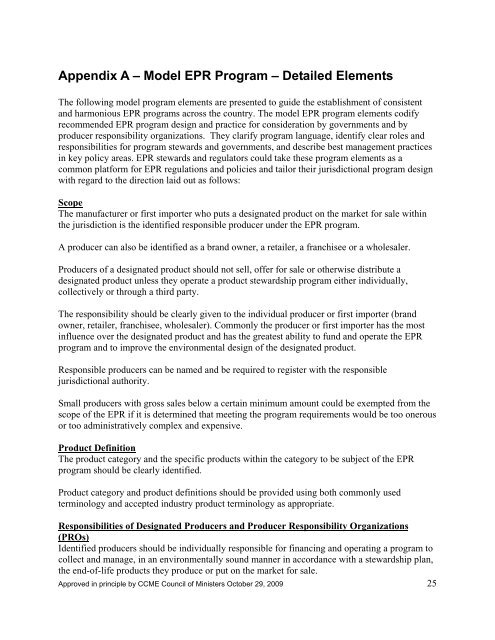Canada-Wide Action Plan for Extended Producer ... - CCME
Canada-Wide Action Plan for Extended Producer ... - CCME
Canada-Wide Action Plan for Extended Producer ... - CCME
You also want an ePaper? Increase the reach of your titles
YUMPU automatically turns print PDFs into web optimized ePapers that Google loves.
Appendix A – Model EPR Program – Detailed Elements<br />
The following model program elements are presented to guide the establishment of consistent<br />
and harmonious EPR programs across the country. The model EPR program elements codify<br />
recommended EPR program design and practice <strong>for</strong> consideration by governments and by<br />
producer responsibility organizations. They clarify program language, identify clear roles and<br />
responsibilities <strong>for</strong> program stewards and governments, and describe best management practices<br />
in key policy areas. EPR stewards and regulators could take these program elements as a<br />
common plat<strong>for</strong>m <strong>for</strong> EPR regulations and policies and tailor their jurisdictional program design<br />
with regard to the direction laid out as follows:<br />
Scope<br />
The manufacturer or first importer who puts a designated product on the market <strong>for</strong> sale within<br />
the jurisdiction is the identified responsible producer under the EPR program.<br />
A producer can also be identified as a brand owner, a retailer, a franchisee or a wholesaler.<br />
<strong>Producer</strong>s of a designated product should not sell, offer <strong>for</strong> sale or otherwise distribute a<br />
designated product unless they operate a product stewardship program either individually,<br />
collectively or through a third party.<br />
The responsibility should be clearly given to the individual producer or first importer (brand<br />
owner, retailer, franchisee, wholesaler). Commonly the producer or first importer has the most<br />
influence over the designated product and has the greatest ability to fund and operate the EPR<br />
program and to improve the environmental design of the designated product.<br />
Responsible producers can be named and be required to register with the responsible<br />
jurisdictional authority.<br />
Small producers with gross sales below a certain minimum amount could be exempted from the<br />
scope of the EPR if it is determined that meeting the program requirements would be too onerous<br />
or too administratively complex and expensive.<br />
Product Definition<br />
The product category and the specific products within the category to be subject of the EPR<br />
program should be clearly identified.<br />
Product category and product definitions should be provided using both commonly used<br />
terminology and accepted industry product terminology as appropriate.<br />
Responsibilities of Designated <strong>Producer</strong>s and <strong>Producer</strong> Responsibility Organizations<br />
(PROs)<br />
Identified producers should be individually responsible <strong>for</strong> financing and operating a program to<br />
collect and manage, in an environmentally sound manner in accordance with a stewardship plan,<br />
the end-of-life products they produce or put on the market <strong>for</strong> sale.<br />
Approved in principle by <strong>CCME</strong> Council of Ministers October 29, 2009 25
















